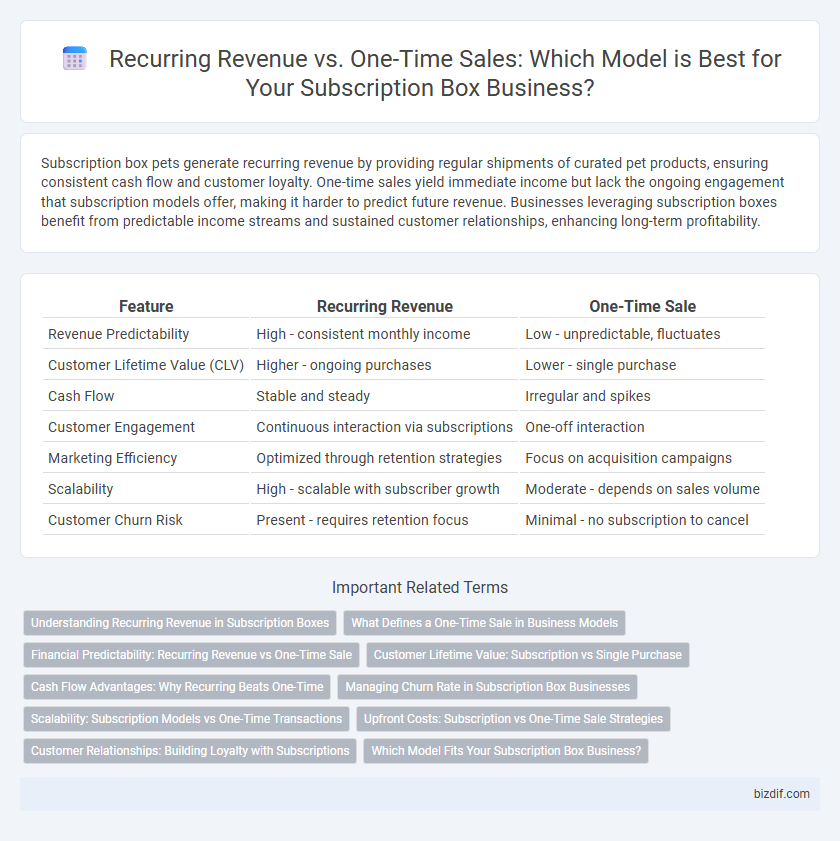Subscription box pets generate recurring revenue by providing regular shipments of curated pet products, ensuring consistent cash flow and customer loyalty. One-time sales yield immediate income but lack the ongoing engagement that subscription models offer, making it harder to predict future revenue. Businesses leveraging subscription boxes benefit from predictable income streams and sustained customer relationships, enhancing long-term profitability.
Table of Comparison
| Feature | Recurring Revenue | One-Time Sale |
|---|---|---|
| Revenue Predictability | High - consistent monthly income | Low - unpredictable, fluctuates |
| Customer Lifetime Value (CLV) | Higher - ongoing purchases | Lower - single purchase |
| Cash Flow | Stable and steady | Irregular and spikes |
| Customer Engagement | Continuous interaction via subscriptions | One-off interaction |
| Marketing Efficiency | Optimized through retention strategies | Focus on acquisition campaigns |
| Scalability | High - scalable with subscriber growth | Moderate - depends on sales volume |
| Customer Churn Risk | Present - requires retention focus | Minimal - no subscription to cancel |
Understanding Recurring Revenue in Subscription Boxes
Recurring revenue in subscription boxes generates predictable, consistent income through automated billing cycles, enhancing cash flow stability and customer lifetime value. Unlike one-time sales, subscription models foster long-term customer engagement by delivering ongoing value and personalized experiences. This sustainable revenue stream supports scalable growth and reduces dependence on fluctuating market demand.
What Defines a One-Time Sale in Business Models
A one-time sale in business models refers to a single transaction where customers purchase a product or service without any commitment to future purchases. This contrasts with recurring revenue models, where customers are charged repeatedly over time, typically through subscriptions or memberships. One-time sales generate immediate income but lack the predictable, sustained cash flow provided by subscription-based recurring revenue.
Financial Predictability: Recurring Revenue vs One-Time Sale
Recurring revenue from subscription boxes offers greater financial predictability by ensuring a consistent cash flow and reducing reliance on unpredictable one-time sales. This steady income enables better budgeting, forecasting, and long-term strategic planning for businesses. In contrast, one-time sales often result in fluctuating revenue streams that complicate financial management and growth projections.
Customer Lifetime Value: Subscription vs Single Purchase
Recurring revenue models from subscription boxes significantly enhance Customer Lifetime Value (CLV) compared to one-time sales by fostering continuous engagement and predictable income streams. Subscription businesses benefit from higher retention rates and the opportunity to upsell or cross-sell over time, which amplifies long-term profitability. In contrast, single purchase customers often result in lower overall CLV due to the absence of repeated transactions and reduced customer loyalty.
Cash Flow Advantages: Why Recurring Beats One-Time
Subscription boxes generate steady recurring revenue that enhances cash flow predictability compared to one-time sales, which often lead to volatile income streams. This consistency allows businesses to better forecast expenses, scale operations, and invest in customer retention strategies. Improved cash flow from recurring payments reduces reliance on continuous customer acquisition, driving sustainable growth.
Managing Churn Rate in Subscription Box Businesses
Managing churn rate is critical for subscription box businesses to maintain stable recurring revenue streams. Recurring revenue from subscriptions provides predictable cash flow, whereas one-time sales create revenue spikes without long-term customer engagement. Implementing retention strategies and analyzing churn metrics help reduce customer attrition, ensuring continuous growth and profitability in the subscription model.
Scalability: Subscription Models vs One-Time Transactions
Subscription models generate predictable recurring revenue, enabling businesses to scale more effectively through customer retention and predictable cash flow. One-time sales rely on constant new customer acquisition, limiting scalability due to fluctuating income and higher marketing costs. Subscription boxes leverage ongoing engagement and lifetime customer value, driving sustainable growth compared to one-time transactions.
Upfront Costs: Subscription vs One-Time Sale Strategies
Subscription box models minimize upfront costs by generating predictable, recurring revenue that stabilizes cash flow and supports scalable inventory management. One-time sale strategies require higher initial investments in production and customer acquisition, often resulting in fluctuating revenue streams and increased financial risk. Prioritizing recurring revenue enables businesses to optimize budget allocation and enhance long-term profitability compared to single-purchase approaches.
Customer Relationships: Building Loyalty with Subscriptions
Subscription boxes foster ongoing customer relationships by delivering consistent value and personalized experiences that one-time sales rarely achieve. Recurring revenue models encourage brand loyalty through regular engagement, increasing customer lifetime value and reducing churn rates. This sustained interaction helps businesses gather richer consumer insights, enabling tailored offerings that deepen emotional connections and trust.
Which Model Fits Your Subscription Box Business?
Recurring revenue provides predictable cash flow and higher customer lifetime value for subscription box businesses, fostering long-term growth and sustainability. One-time sales generate immediate income but often require constant acquisition efforts and offer limited customer retention opportunities. Choosing the right model depends on factors like target market preferences, product type, and business scalability goals.
Recurring Revenue vs One-Time Sale Infographic

 bizdif.com
bizdif.com